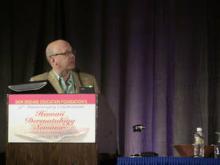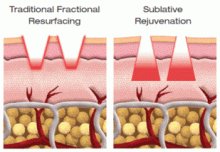User login
Sublation appears to be the new "it" word in skin laser rejuvenation. Studies have found that a device utilizing sublative technology was safe and effective for skin tightening and treating acne scars, even in darker skinned patients.
Dr. David J. Goldberg, director of dermatologic laser research at Mount Sinai School of Medicine, New York, presented early trial results at the Hawaii Dermatology Seminar sponsored by Skin Disease Education Foundation (SDEF).
Besides being safe, effective, and offering minimal downtime, an immediate impact was seen after sublation through histopathology imaging. The small, fractionated, bipolar, radio-frequency device (Syneron eMatrix system) delivers energy deep into the dermis with limited skin surface involvement. Dr. Goldberg described the energy as entering an upside down cone. The energy spreads out as it goes deeper into the skin.
Compared with ablative resurfacing, sublative rejuvenation has the same healing physiological pathway (healing cascade) and the same initiating event (inflammation), said Dr. Goldberg. However, sublation has different perdominant events and there is a different proportion of dermal/epidermal involvement. Once again, said Dr. Goldberg, for delivering energy, think upside down cone, compared with the cone of ablation.
Initial studies at four sites in the United States and Canada of about 80 patients, with an average age of 52 and Fitzpatrick skin types I-IV, found that 83% of patients had improved skin brightness, 87% had improved skin tightness, and 90% had wrinkle improvement. Full data will be presented in April at the American Society for Laser Medicine and Surgery meeting in San Antonio.
In another study of patients with Fitzpatrick skin types IV-VI treated with the sublative laser, early results found improved photo damage and acne scarring after treatment. There was little erythema after treatment, said Dr. Goldberg.
He stressed that the results are early, and "only time will tell" if this device will live up to its early hype.
Dr. Goldberg disclosed receiving research grants from Syneron. SDEF and this news organization are owned by Elsevier.
-Amy Pfeiffer
Sublation appears to be the new "it" word in skin laser rejuvenation. Studies have found that a device utilizing sublative technology was safe and effective for skin tightening and treating acne scars, even in darker skinned patients.
Dr. David J. Goldberg, director of dermatologic laser research at Mount Sinai School of Medicine, New York, presented early trial results at the Hawaii Dermatology Seminar sponsored by Skin Disease Education Foundation (SDEF).
Besides being safe, effective, and offering minimal downtime, an immediate impact was seen after sublation through histopathology imaging. The small, fractionated, bipolar, radio-frequency device (Syneron eMatrix system) delivers energy deep into the dermis with limited skin surface involvement. Dr. Goldberg described the energy as entering an upside down cone. The energy spreads out as it goes deeper into the skin.
Compared with ablative resurfacing, sublative rejuvenation has the same healing physiological pathway (healing cascade) and the same initiating event (inflammation), said Dr. Goldberg. However, sublation has different perdominant events and there is a different proportion of dermal/epidermal involvement. Once again, said Dr. Goldberg, for delivering energy, think upside down cone, compared with the cone of ablation.
Initial studies at four sites in the United States and Canada of about 80 patients, with an average age of 52 and Fitzpatrick skin types I-IV, found that 83% of patients had improved skin brightness, 87% had improved skin tightness, and 90% had wrinkle improvement. Full data will be presented in April at the American Society for Laser Medicine and Surgery meeting in San Antonio.
In another study of patients with Fitzpatrick skin types IV-VI treated with the sublative laser, early results found improved photo damage and acne scarring after treatment. There was little erythema after treatment, said Dr. Goldberg.
He stressed that the results are early, and "only time will tell" if this device will live up to its early hype.
Dr. Goldberg disclosed receiving research grants from Syneron. SDEF and this news organization are owned by Elsevier.
-Amy Pfeiffer
Sublation appears to be the new "it" word in skin laser rejuvenation. Studies have found that a device utilizing sublative technology was safe and effective for skin tightening and treating acne scars, even in darker skinned patients.
Dr. David J. Goldberg, director of dermatologic laser research at Mount Sinai School of Medicine, New York, presented early trial results at the Hawaii Dermatology Seminar sponsored by Skin Disease Education Foundation (SDEF).
Besides being safe, effective, and offering minimal downtime, an immediate impact was seen after sublation through histopathology imaging. The small, fractionated, bipolar, radio-frequency device (Syneron eMatrix system) delivers energy deep into the dermis with limited skin surface involvement. Dr. Goldberg described the energy as entering an upside down cone. The energy spreads out as it goes deeper into the skin.
Compared with ablative resurfacing, sublative rejuvenation has the same healing physiological pathway (healing cascade) and the same initiating event (inflammation), said Dr. Goldberg. However, sublation has different perdominant events and there is a different proportion of dermal/epidermal involvement. Once again, said Dr. Goldberg, for delivering energy, think upside down cone, compared with the cone of ablation.
Initial studies at four sites in the United States and Canada of about 80 patients, with an average age of 52 and Fitzpatrick skin types I-IV, found that 83% of patients had improved skin brightness, 87% had improved skin tightness, and 90% had wrinkle improvement. Full data will be presented in April at the American Society for Laser Medicine and Surgery meeting in San Antonio.
In another study of patients with Fitzpatrick skin types IV-VI treated with the sublative laser, early results found improved photo damage and acne scarring after treatment. There was little erythema after treatment, said Dr. Goldberg.
He stressed that the results are early, and "only time will tell" if this device will live up to its early hype.
Dr. Goldberg disclosed receiving research grants from Syneron. SDEF and this news organization are owned by Elsevier.
-Amy Pfeiffer

